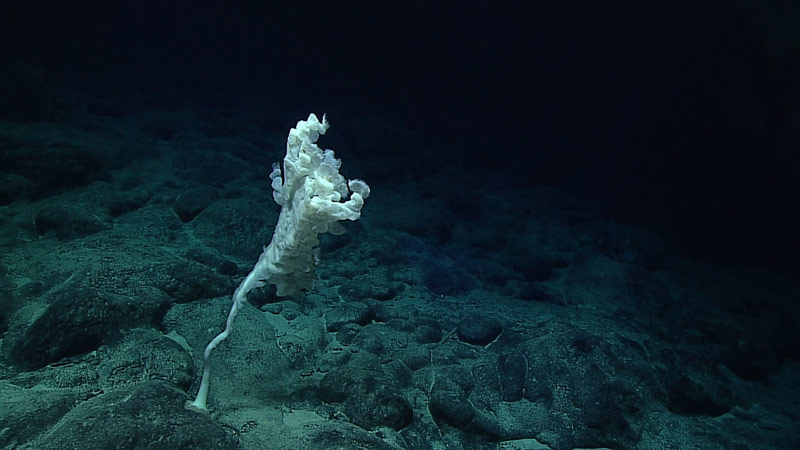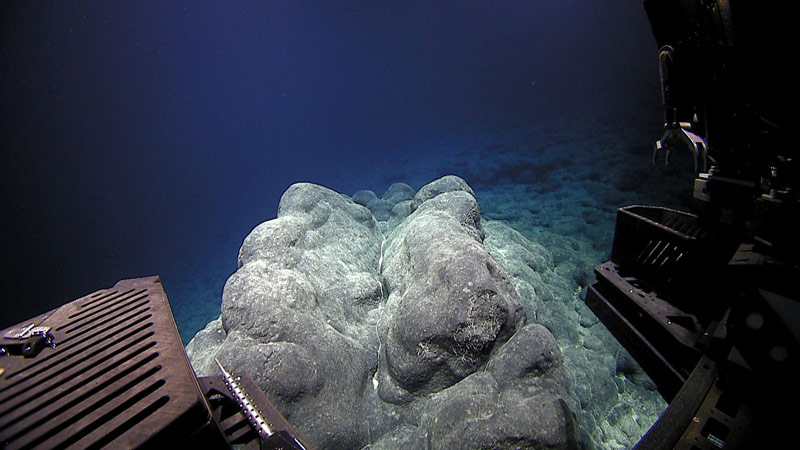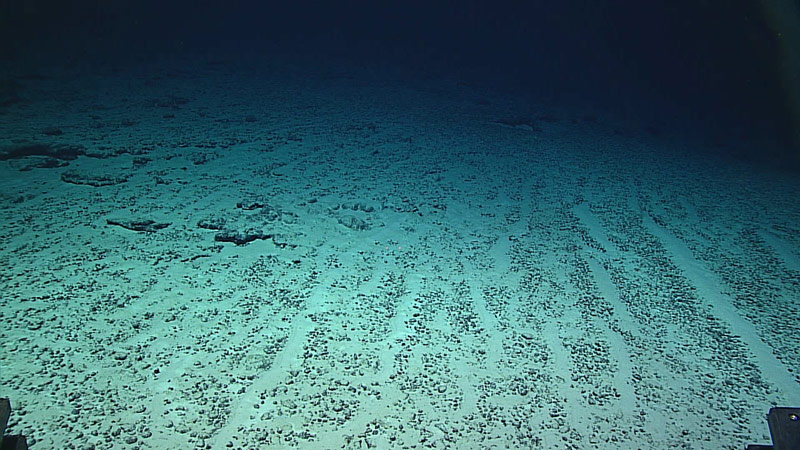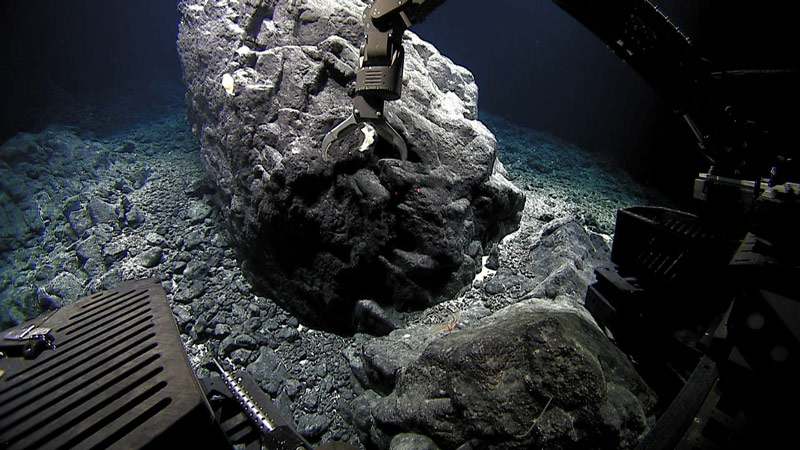
By Diva Amon, University of Hawaii at Manoa
August 13, 2016
Disclaimer: I am not a geologist. I don’t even like rocks. But I recognize that they’re pretty darn important and, in fact, without them, there wouldn’t be a whole lot of biology down in the deep sea.

A Caulophacus sponge anchored to the seafloor. Image courtesy of the NOAA Office of Ocean Exploration and Research, Deepwater Wonders of Wake. Download larger version (jpg, 617 KB).
You may have realized that the science party can often predict the types of animal communities that we may encounter on a dive long before the Deep Discoverer remotely operated vehicle has even reached the bottom. For example, on many of the dives during the current Deepwater Wonders of Wake expedition, we have guessed (or hypothesized, as we scientists say!) that we would touch down on a seafloor laden with corals and sponges. Of course, we don’t always get it right (that happens more than you think in science), because the success of a certain species or community is determined by lots and lots and lots of different factors: the local ocean chemistry, temperature, currents, predator presence, food availability, etc. However, the most influential factor, and the reason we can sometimes predict what fauna we might see, is the geology.
On a large scale, plate tectonics is responsible for the shape of the seafloor: the giant mid-ocean ridge mountain ranges, the deep ocean trenches, and the flat abyssal plains. This huge variety of geological environments in the deep ocean provides habitat for many different communities of weird and wonderful animals.
For instance, stable tectonically inactive areas can have very old large communities of sessile (immobile) organisms, such as those seen on the Cretaceous-age guyots we visited during the Deepwater Exploration of the Marianas expedition and now on the Wake expedition. By contrast, there can be very little life in volcanically active areas, such as the new glassy lavas we also had a chance to explore during the Marianas expedition. In this case, the recent “repaving” of the seafloor was so new that animals have not yet had the chance to colonize it.

Clearly visible pillow lavas seen during the exploration of an unnamed seamount despite the fact that the seamount is quite old and manganese-crusted. Image courtesy of the NOAA Office of Ocean Exploration and Research, Deepwater Wonders of Wake. Download larger version (jpg, 761 KB).
Magma, the molten rocks deep within the Earth, also drive the movement of hot, chemical-rich fluids that are expelled from the seafloor at hydrothermal vents. These areas build up towering chimneys and host totally unique communities of chemosynthetic animals, many of which are found nowhere else on the planet.
Even on smaller scales, geology has an impact. How hard or soft the seafloor is plays a huge role. In soft-sediment environments, there tend to be many organisms (called infauna) living within the sediments of the seafloor – anything from tiny crustaceans to large burrowing urchins and slithering enteropneusts. Soft sediments are often unconsolidated and so can be easily moved around, providing a lot of 3-D space to burrow but few opportunities to anchor.

The soft-sediment environment of an unnamed seamount off of Wake Island. This sandy habitat likely provides homes for many critters living directly within the sediments of the seafloor. Image courtesy of the NOAA Office of Ocean Exploration and Research, Deepwater Wonders of Wake. Download larger version (jpg, 1 MB).
This is the opposite of hard substrates, which are dominated by epifauna (animals that live on top of the seafloor). Hard-bottomed areas, such as the ferromanganese-encrusted seamounts featured during this expedition, tend to have sessile animals such as sponges, anemones, and corals. Although, every so often we find animals that surprise us, like the stalked Caulophacus sponges we found in the soft sediment atop several mud volcanoes during the Marianas expedition, with large root structures anchoring them in the soft mud.

Scientists use Deep Discoverer to collect a rock sample from a hard-substrate environment. Image courtesy of the NOAA Office of Ocean Exploration and Research, Deepwater Wonders of Wake. Download larger version (jpg, 915 KB).
In addition to how soft or hard the seafloor is, the size of the substrate matters too! A small rock is much more likely to roll around than a large boulder, and no one wants a rolling home. That means that there tend to be larger, more vibrant communities on large, intact outcrops than on piles of loose talus.
Another factor is the steepness of the terrain, although this has a different impact in the sea than on land. Gravity makes it difficult for plants and animals to grow on steep cliffs on land, but in the deep sea, the effects of gravity are much lower. In fact, it can be beneficial for animals to live on steep terrain. Strong currents can whip around cliff faces and pinnacles, ensuring a steady supply of food for many large sessile suspension feeders like corals and sponges. Steeper slopes also don’t accumulate much sediment.
In areas of the deep sea with high rates of sedimentation, small sessile animals can actually get buried, leading to death. If you’re a coral, it’s probably better to live on a cliff side than on the neighboring, sedimented ledge. Interestingly, the larvae of many broadcast-spawning species, such as deep-sea corals, don’t have a choice about where they settle, and so to increase chances of offspring landing in a suitable habitat, hundreds to thousands of larvae can be released into the water column.
So, even though I sometimes get a little bit bored staring at a ferromanganese-encrusted seamount for hours on end, I’ll be one of the first to tell you that geology matters. In fact, I might even go so far as to say it rocks. ;)